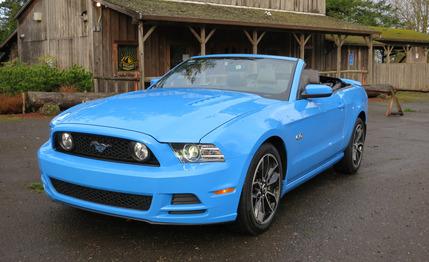
 First Drive Review
First Drive Review
The challenge of keeping an automotive legend evergreen increases in direct proportion to its age, which makes the perpetuation of the Ford Mustang one of the most formidable assignments in American autodom. How well the stewards of this 49-year-old icon discharge their sobering duty is a function of their creativity, their understanding of both Mustang loyalists and potential Mustang wannabes, and—the essential element—budget.
However passionate the keepers of the faith may be, the compelling improvements they might like to install are inevitably tempered by the corporate funding apportioned to the task. The people who file P&L statements aren’t known for their automotive passions, and even less for sentimentality.
With that in mind, the latest updates to the mainstream Mustang, on sale now as an early 2013 model, add up to a freshening. It entails a number of styling tweaks, some cool performance-measuring electronics, a Recaro-seat option (leather or cloth, adapted from the GT500 and Boss 302), a very modest increase in the output of the Mustang’s 5.0-liter V-8, and a couple Shaker sound systems capable of rousing sound sleepers in the next county (and making them glad they woke up).
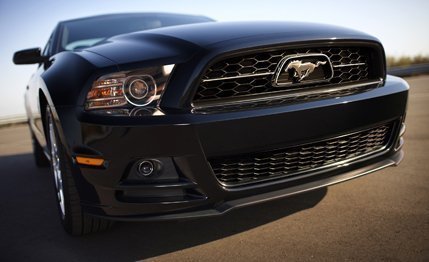

Look Closely
The styling updates are subtle but probably obvious to Mustang cognoscenti, and just extensive enough to make the cars look new to potential converts. The grille is more prominent, the front splitter has been revised, and the hood is adorned with a pair of louvered heat-extractor vents that are actually functional. HID headlamps are standard on all models, and they’re flanked by LED light bars that lend a little more distinction to the front-end treatment. Also new on the lighting front are optional side-mirror puddle lamps that project images of the Mustang’s famous pony emblem onto the pavement when the driver unlocks the car. Very important.
All rocker panels will be body color on the 2013 Stangs, and the new LED taillights—which retain the well-loved sequential-turn-signal function—blink behind smoked lenses. Speaking of colors, a couple zany new ones have been added. Called Deep Impact Blue and Gotta Have It Green, they’re consistent with the Mustang’s uninhibited palette, and are probably visible at a distance in double-zero fog. In the same vein, there are several new wheel designs, ranging from 17 to 19 inches, including an optional GT wheel that Ford characterizes as “sinister.”
Track Apps
Aside from the addition of the new Shaker audio options and available SelectShift six-speed automatic transmission (more on this later), the inner Mustang looks very familiar—when does retro become merely old?—unless it happens to be equipped with the newly available 4.2-inch LCD display with its Track Apps features. Ford calls the display a “productivity screen” that allows drivers to monitor all kinds of data—engine info such as cylinder-head temps and air-fuel ratio, a trip computer, and fuel economy broken out in as many as three time periods. But the coolest element is Track Apps, which gives the driver g-loading, braking performance (60- and 100-to-0 mph), and acceleration: 0–60, 0–100, eighth- and quarter-mile. A little drag-strip “Christmas tree” countdown light comes up for acceleration runs, and the system also warns that it’s “for track use only.” Wink wink.
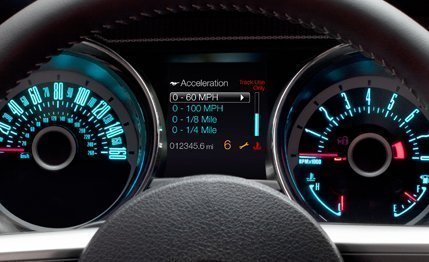

At the Helm
The Mustang’s dynamic résumé for 2013 is essentially unchanged from the 2012 model. As noted, Ford has found eight more ponies in the 5.0-liter V-8, achieved by applying Boss 302 piston coatings and discontinuing the oil squirts formerly cooling the undersides of the pistons, a function the engineers now believe to be unnecessary based on experience with the 5.0. The primary benefit here is probably cost reduction; the jump from 412 to 420 hp is essentially academic. The 2013 GT responds just as eagerly when the driver tramps on the gas, emitting a seductive baritone bark as it does so. We forecast perhaps a tenth-of-a-second improvement in 0-to-60-mph acceleration for V-8 cars.
Although the 5.0 trails industry trends in terms of its port fuel-injection system—Ford has yet to see a compelling cost-benefit case for direct injection—this is a lovely engine that will satisfy all but the most power-hungry. For that matter, the 305-hp, 3.7-liter V-6 produces respectable hustle, and, with the optional Performance package, is very entertaining on a stretch of winding road, thanks to its lower weight compared to its V-8 sibling.
Automatic Convertible Blues
Our ride for a brief preview drive was a GT convertible, resplendent in Grabber Blue, and equipped with the optional Shaker Pro audio system—one-word summary: wow!—and the updated six-speed SelectShift automatic. We could offer several one-word summaries for this device, too, but since none are positive, let’s be specific instead. As the name suggests, this transmission setup is intended to offer the driver manual gear changes, but anyone who has experienced a good paddle-shifted dual-clutch automatic will be, at best, disappointed.
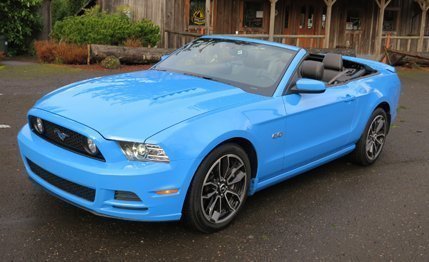

Rather than using paddles, on-demand shifting with this auto is achieved by operating a little rocker switch on the side of the shift lever; shifts are slow, and since the center console encroaches on the driver’s right arm, access to the shift switch can be awkward. This device does nothing to amplify the pleasures of this otherwise snazzy pony ragtop—quite the contrary. Memo to accounting: Pump some money into your Mustang automatic-transmission budget.
A couple other kvetches. Though it closed easily (via two header latches) and sealed well, the hardened forward portion of our convertible’s power top, which doubles as a tonneau when the top is down, refused to lie flat atop the well behind the rear passenger seats. And the continued absence of a telescoping steering column makes it difficult to get an optimal driving position.
On the other hand, Ford’s electric power-steering system (EPAS), which now offers three operating modes (Comfort, Standard, and Sport), is surprisingly informative in the Mustang, the convertible chassis is robust, and if transient responses could be sharper with an independent rear suspension, the chassis team has done more with a classic solid rear axle than many thought possible.
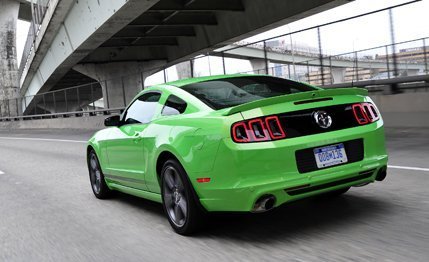

The Price of Doing Business
Mirroring the subtle changes made to the car, 2013 Mustang prices are only slightly adjusted from 2012’s totals, with some models getting a little cheaper and some seeing small price increases. The least-expensive Mustang, a manual-equipped V-6 coupe, starts at $22,995; the GT at $31,095. Convertibles with the V-6 and a manual transmission open at $27,995, and the GT starts at $36,095. An automatic adds $1195 to the bill.
Independent rear suspension, like some other useful upgrades, will have to wait for an infusion of money. Hopefully that will arrive along with the car’s 50th anniversary and the next-generation model in 2014. Are you listening, budget department?